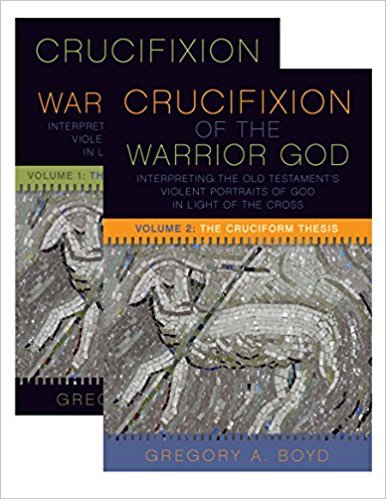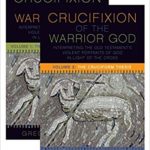We run our website the way we wished the whole internet worked: we provide high quality original content with no ads. We are funded solely by your direct support. Please consider supporting this project.

Reviewing the Reviews: Derek Flood
In this second “Review of the Reviews” of Crucifixion of the Warrior God, I will discuss the three-part review of Derek Flood. In part 1 Derek provides a nice overview of the Introduction through chapter 2. He correctly notes that
Greg’s goal in writing the book is to show how it is possible to affirm the inspiration of all of Scripture…including these violent portraits, while at the same time recognizing that they are, at face value, at odds with and opposed to the revelation of God in Christ.
Moreover, Derek correctly notes that I hold that the key to doing this is to center our interpretation of Scripture on Christ (though I argue it should more specifically be anchored on Christ crucified).
In part 2 Derek jumps to chapter 8, and here Derek takes issue with my work. In this chapter I argue against what I call “the Dismissal Solution,” and it includes all who believe that the challenge posed by Scripture’s violent portraits of God can be solved by arguing against these portraits on historical, theological, or ethical grounds. To Derek’s chagrin, I include his work, Disarming Scripture, in this category.
I am sorry if this offended Derek. And if I have misunderstood him, I apologize. Yet, to be frank, it seems to me his rebuttal confirmed the appropriateness of including him in this category. For example, Derek discusses the portrait of God commanding the Israelites to slaughter all the inhabitants of Jericho once its walls fell down. “When we learn from high-precision radiocarbon dating that Jericho was destroyed more than a century before Joshua ever got there,” he argues, “that kind of changes things.” For it means that “God, in fact, didn’t say this and didn’t do that because the entire thing simply never happened.”
As I argue at length in the very chapter Derek is discussing, I don’t believe the radiocarbon dating of Jericho changes anything. For it is the text of Scripture that is divinely inspired, regardless of how scholars assess its relationship to “actual history” (which, of course, is always a particular scholar’s reconstruction of what happened). Hence, the challenge posed by this (and every other) violent portrait of God remains, even if one accepts that the narrative doesn’t correspond to “actual history.”
Derek is also baffled by my view, for he correctly notes that I earlier argued that people who are committed to seeing Jesus as the full revelation of God must reject the violence that is attributed to God in the OT, and I cite Jesus’ repudiation of aspects of Scripture as a precedent for this. What Derek seems to have missed, however, is that I don’t believe that repudiated biblical material is any less inspired than any other portion of Scripture, and it is all divinely inspired for the ultimate purpose of bearing witness to the cross. And this is precisely why I insist that rejecting the violence that is ascribed to God in the OT is not a stopping point. Out of fidelity to Christ, I argue, we must continue to search for how these violent portraits reveal God – the same God who is revealed on the cross.
Derek is of course free to disagree with my view. But given that this is the view I hold, surely he can understand why I would view him as advocating a version of the dismissal solution.
In part 3 Derek continues his review up through the first two chapters of volume II. Referring to a portrait of God orchestrating the public raping of David’s wives as punishment for David, Derek correctly notes that I am arguing that “in the very ugliness of such passages we can see Christ’s beauty, just as we see this in the ugliness of the cross.”
About this, however, Derek writes: “The problem with this, of course, is that it does not,” for the ugliness of violent divine portraits is “categorically not a parallel to the cross, but its polar opposite.” For the violent portraits of God in the OT present God as “a perpetrator of violence,” whereas on the cross we see God as “a victim of violence on Calvary” (CWG, 642).
Here is where things frankly begin to get a bit strange for me.
Derek is quoting me above from an early section in chapter 13 where I’m introducing the issues I’m going to address. Oddly enough, Derek proceeds to review this chapter almost as though I never addressed the issue I just introduced. Stranger still, he argues that I have “a fundamental misunderstanding of how the cross functions as an expression of non-violent enemy-love,” because “[p]roperly understood, the cross is about seeing God in Jesus as the innocent victim of violence.” Yet, this is the very position I defend, and I defend it in this very chapter.
Derek then reviews Girard’s scapegoat theory to offer the proper understanding of how the cross functions as an expression of non-violent enemy-love. But this too strikes me as odd, because, while I am not a fully convinced Giardian, I also rely on Girard to defend this perspective of the cross and to explain why God is depicted as “a perpetrator of violence” in the OT but “a victim of violence on Calvary.” I argue that, whereas God stooped to bear his people’s sinful conceptions of him as a perpetrator of violence in the OT, on the cross God stoops to bear our sin by suffering as a victim of violence. And in good Girardian fashion, I argue that God does this
…as a means of exposing the whole scapegoating mechanism to be the lie that it is….Only by willingly becoming the guilty-appearing victim of our violence and then triumphing over it in the resurrection could God reveal his true, loving, self-sacrificial nature, thereby unveiling the truth that all contrary depictions of God in the written witness to his covenantal faithfulness are projections of his people’s primeval destruction reflex and guilt (CWG 698-99).
Thus far I think Derek and I agree. But I believe Derek thinks he is applying Girard’s thought differently than I do to the OT violent portraits of God. He argues that instead of looking “deeper,” as I advocate, we should rather look “wider,” for the manner in which the OT violent portraits of God contrast with other non-violent divine portraits which allows us to see in the violent portraits “the sin of religiously justified violence mirrored before us.”
Derek wonders if I’ll “find this approach compelling,” but the fact of the matter is that I employ it throughout volume 2, but especially in chapter 14 which was included in Derek’s review. I continually contrast the OT’s more Christ-like portraits of God in which we can see the Spirit of Christ breaking through with its violent portraits in which we can see that the hard heartedness and cultural conditioning of God’s ancient people did not allow the Spirit to break through. So I completely agree with the “wider” reading of these violent divine portraits.
Where I part ways with Derek is that in my view, this wider contrast confirms that God is bearing the sin of his people when he allows himself to be depicted along the lines of the ANE violent deity. But it is only the deep, cross-centered reading that reveals this truth. And, as my earlier quote makes clear, I use Girard to explain why on the cross God needed to take on the semblance of a guilty victim of violence.
And this brings me to my final and most fundamental point. Derek doesn’t approve of this concept of looking “deeper.” Curiously enough, however, Derek nowhere discusses how this “looking deeper” is anchored to my assessment of how the cross becomes the full revelation of God for believers (ch.11, CWG). This is the foundation of my entire Cruciform Thesis, and judging from the fundamental way Derek misunderstood some of the material he reviewed, I’m not completely confident he understood it.
For example, Derek apparently thinks he is arguing against my position when he notes that the earlier mentioned story of David being punished by having his wives publically raped “is clearly not a story of God ‘bearing sin’ at all, but of God allegedly decreeing the sin of rape, portrayed as just punishment.” I can’t imagine how Derek would think I would think otherwise if he understood this foundational concept.
I argue that stories involving violent portraits of God only become stories of God bearing the sin of his people when we exercise the same faith that we employ to see the cross as the definitive revelation of the sin-bearing God. While the ugly surface appearance of the cross mirrors the ugliness of our sin, the cross becomes the full revelation of God when we by faith look through this ugly sin-mirroring surface to behold the all holy God stooping an infinite distance to enter into solidarity with our sin and God-forsaken curse. So too, we only discern how violent portraits of God bear witness to the cross only when we by faith look through their ugly sin-mirroring surface (reflecting the author’s original intended meaning) to see God stooping as low as necessary to remain in covenantal solidarity with his people.
So of course the hideous story of David’s wives being raped isn’t a story about God bearing sin, if you’re assessing it according to its original intended meaning. The question is, can we who know God as he’s revealed on the cross see anything else going on behind the scenes of this story, just as we see something else going on behind the scenes of the crucified Nazarene?
This misunderstanding perhaps explains the stunning conclusion of Derek’s review, for he claims that in the last ten chapters of Volume II (chs 15-25) I present “an apologetic for God’s violent judgments in the OT as loving and just.” That statement left me nonplussed. My entire thesis is predicated on the insistence that the violent judgments of God cannot be justified, let alone made to look “loving and just”! Indeed, I argue that it is only when we abandon all attempts to justify them that we can see how these violent portraits bear witness to the cross.
I know Derek to be a sharp thinker with a Jesus-loving heart of gold, which is why he rightfully deplores the violent portraits of God in Scripture. But this is precisely why I’m so puzzled as to how he could have so completely misread me. I again am sorry if I offended and/or misunderstood him, but I’m left wondering if perhaps his chagrin over chapter 8 jaundiced his subsequent reading of my work.
Category: General
Tags: Crucifixion of the Warrior God, Derek Flood, Disarming Scripture, Reviews
Related Reading

Where Does Jesus Affirm the Principle of Accommodation? (podcast)
Greg looks at Jesus as a perfect revelation of God, and considers how Jesus himself reveals an accommodating God in the Old Testament. Episode 598 http://traffic.libsyn.com/askgregboyd/Episode_0598.mp3

A Cruciform Magic Eye
In this post I’d like to share the story of how I came upon the thesis I’m defending in the book I’ve been working on for the last four years entitled The Crucifixion of the Warrior God: A Cruciform Theological Interpretation of the Old Testament’s Violent Divine Portraits. It’s a much longer post than usual,…

Greg’s Interview on The Christian Transhumanist Podcast
Here is an interview I did for The Christian Transhumanist Podcast that I wanted to share with all of you. Micah Redding and I discuss everything from Relativity Theory to Politics. I think you’ll find it interesting, but I want to offer a word of clarification before you listen. At one point in this interview…

Podcast: Does the Cruciform Hermeneutic Sabotage Open Theism?
Greg plays Peek-a-Boo with God and considers whether those verses Open Theists use to support Open Theism might simply be times when God is accommodating for us. http://traffic.libsyn.com/askgregboyd/Episode_0236.mp3

The Greatest in the Kingdom (2 of 2)
Article by Natalie Frisk This post is a summary of what was discussed at the ReKnew CrossVision Conference in regard to what and how we teach our kids about the cruciform hermeneutic. Taking Jesus into the Old Testament I co-lead a family-friendly home church where we sometimes get into spiritually deep conversations with children. There…

Reviewing the Reviews: Tom Belt (Part 1)
Tom Belt has written a four-part review of Crucifixion of the Warrior God on his blog An Open Orthodoxy. Parts 1 and 2 offer an overall fair and balanced summary of CWG, at least to the point that correcting misunderstandings would feel petty. In Part 3 Tom offers a critique of volume I, and this is what I’d like…
